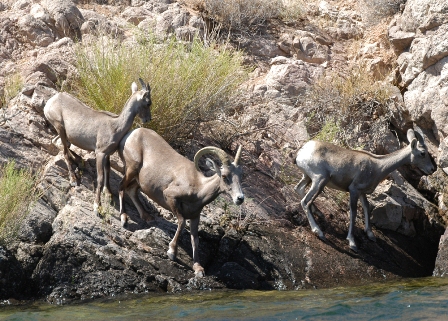
Some sheep just aren’t meant to be together.
Wild bighorn sheep populations across Arizona are picking up diseases from domesticated sheep and pack goats. As a result, the Arizona Game and Fish Department is working to protect the wild sheep throughout the Sonoran mountain ranges.
Mycoplasma pneumonia, sinusitis and other respiratory diseases have been lethal to bighorn sheep. Mycoplasma conjunctivitis causes blindness.
“Bighorn sheep are very susceptible and at high-risk of being infected by bacteria from domestic sheep and goats,” said Anne Justice-Allen, Wildlife Health Program Supervisor for the department. “We have a dilemma in how to protect the bighorn sheep, especially since we don’t have vaccines that we can give them.”
Increased human development has exposed bighorn sheep to domestic sheep and goats, therefore subjecting wild bighorns to bacteria that their immune systems cannot defeat.
In 2003 and 2004, the infectious keratoconjunctivitis (IKC), also known as “pink eye,” affected a population of bighorn sheep in the Silver Bell Mountains, which are located west of Tucson, Arizona. Although “pink eye” is generally not fatal, the disease is highly contagious and can be transmitted to lambs born to mothers who carry the disease.
Jim Heffelfinger, Regional Game Specialist for the Arizona Game and Fish Department, said they discovered the bighorns had been in contact with domestic goats.
“When we came across the bighorn sheep in the Silver Bell range, it became a big problem when we realized there had been contact with domestic goats,” Heffelfinger said. “Bighorns were affected for months and numerous sheep were actually blinded, some permanently.”
In addition to pink eye outbreaks, the more serious diseases to bighorn sheeps are pneumonia and sinusitis. Depending on the domestic sheep or goats that carry the disease, the strains of pneumonia and sinusitis can differ, according to Heffelfinger.
As conservation efforts seek to restore bighorn populations, pneumonia can decimate herds. The Kofa National Wildlife Refuge near Yuma, Arizona, estimated more than 800 bighorn sheep in 2000. Current estimates are counting less than 400 bighorn sheep, a 50 percent decline.
“Can we just say that disease is the reason why bighorn sheep aren’t expanding and growing? No, not exactly, but these illnesses, like pneumonia and sinusitis, don’t help the cause,” Heffelfinger said.
Without treatments to manage and eradicate illnesses among bighorn sheep, wildlife specialists are developing new management strategies.
“They are revered animals in American history, and we want to make sure they are able to thrive,” said Mark Hart, spokesman for the Arizona Game and Fish Department. “Keeping them out of harms way of diseases is something we take seriously, especially since drought and predation are already something to deal with.”
Arizona Game and Fish estimates about 6,000 bighorn sheep across the state as of March, but these numbers pale in comparison to native populations from the early to mid twentieth century.
During a presentation at an Arizona State Parks meeting in March, Justice-Allen offered recommended management practices to sustain bighorn sheep populations, including the effective use of spatial separation.
As bighorn sheep are transplanted back into their native homelands, the animals need to be completely separated from any domestic sheep or pack goats, Justice-Allen said. Also, diligent identification of bighorn sheep is vital to monitoring the animals as they roam the wilderness.
Using radio collars and GPS map technology, wildlife specialists with Arizona Game and Fish and the U.S Fish and Wildlife Service are tracking the bighorn sheep. If a bighorn is immobile for more than eight hours, a mortality signal is sent to the specialists. They can effectively track and investigate to determine the cause of death, though sometimes ewes, or female bighorns, can be resting for long periods of time during lamb births.
The spread of diseases within herds can be the difference between one death and months of contagion, according to Justice-Allen.
“We all need to encourage prompt reporting and stay on top of this problem moving forward,” said Justice-Allen. “We have identified the problem and the risks. Now we need to make the right decisions in helping these bighorn sheep to stay healthy and birth healthy lambs.”
Re-introduction of bighorn sheep to their natural habitats in Arizona has been a priority for the Arizona Game and Fish Department, including the transplant of 30 Desert Bighorn Sheep in the Pusch Ridge Wilderness Area of the Santa Catalina Mountains near Tucson in November 2013.
According to Justice-Allen and Hart, the hope is that the translocation project in the Catalina Mountains can serve as a stepping stone for similar bighorn reintroductions around the state.
“We want to have at least 100 bighorn sheep transplanted into the Pusch Wilderness within the next few years,” Hart said. “We must learn now and try to keep diseases away from the bighorn sheep before we just go out and put more of these great animals at unnecessary risk.”
Cam Chery is a reporter for Arizona Sonora News, a service from the School of Journalism with the University of Arizona. Contact him at [email protected].

